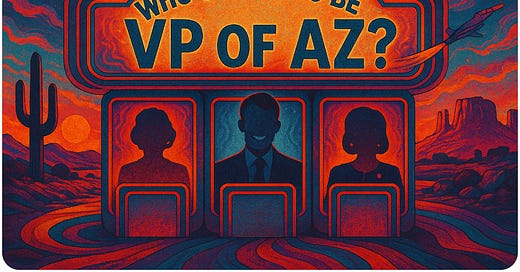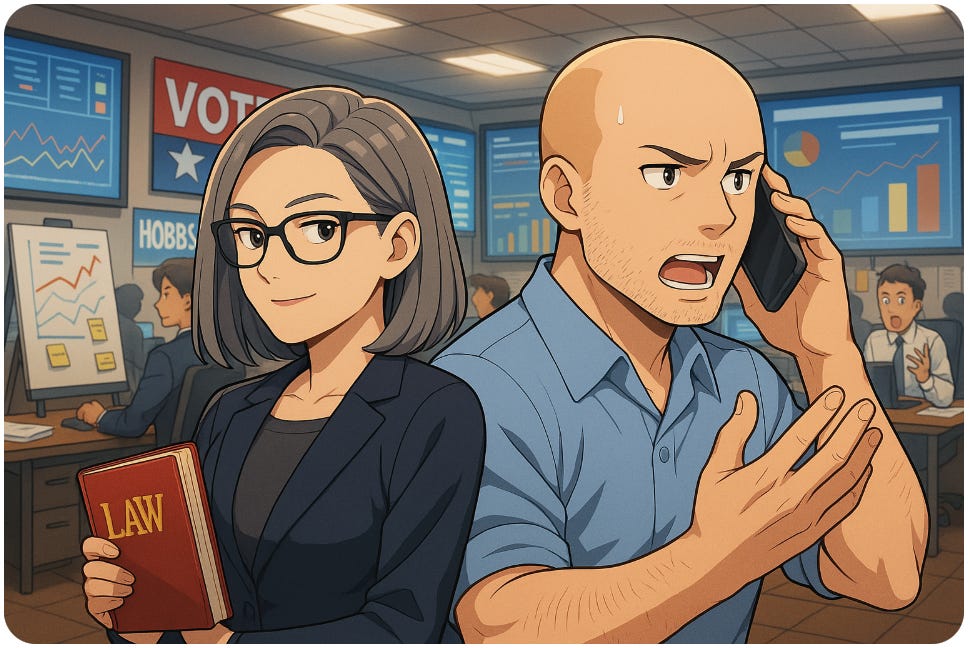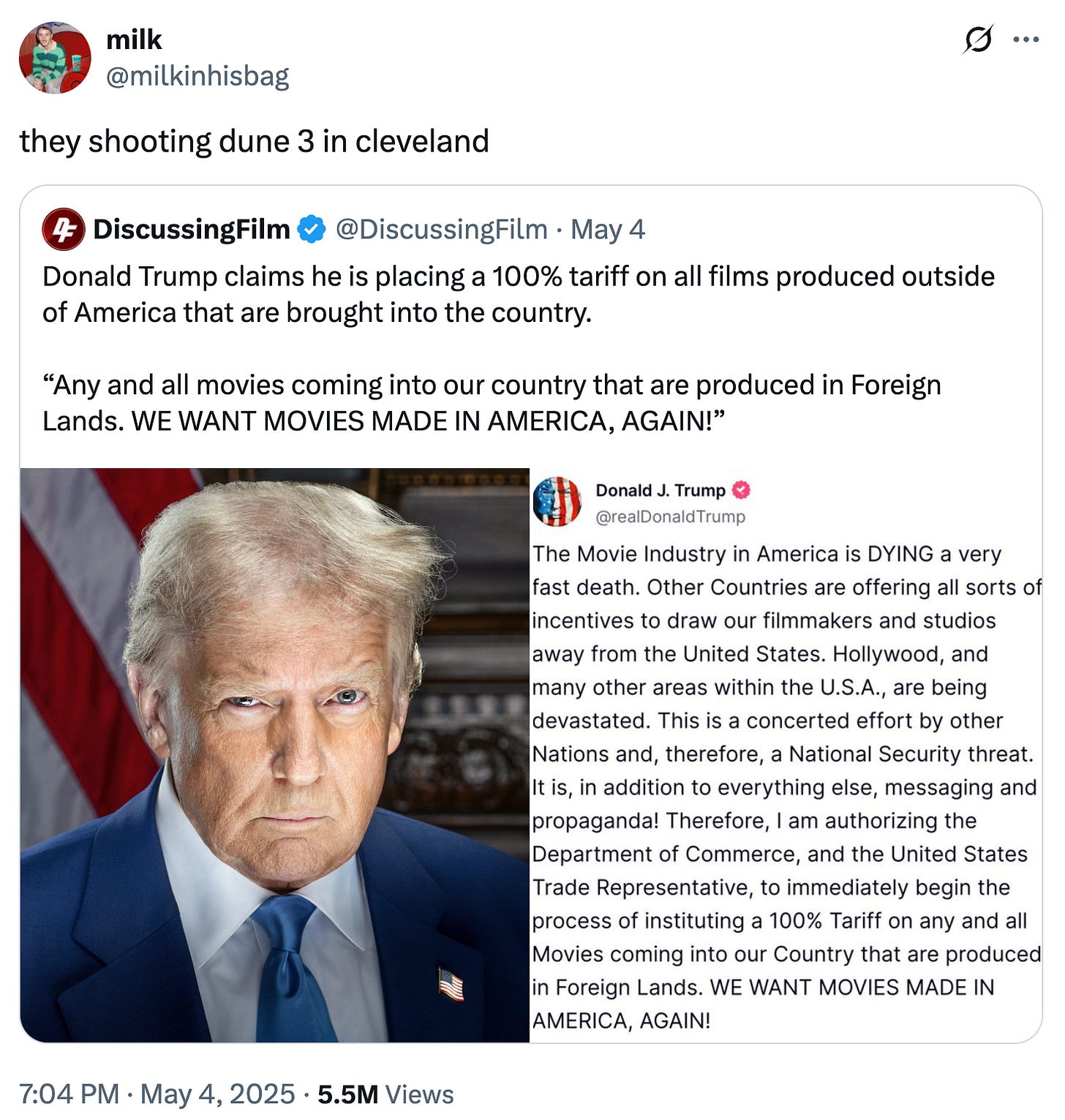
The VP of AZ
Shipping the candidates … Budget woes and budget whoas … And snowflakes freeze out the press.
Political prognosticators are already labeling Arizona’s 2026 governor’s race a “toss-up” and debating the strengths and weaknesses of Gov. Katie Hobbs and her two potential challengers, Republicans Karrin Taylor Robson and Andy Biggs.
But the 2026 gubernatorial election will be played by a whole different set of rules than Arizona politicos are used to.
That’s because, for the first time in Arizona’s history, when voters weigh their options for their next governor, they’ll also be hiring a lieutenant governor.
The lieutenant governor is a running mate listed on the ballot alongside the candidate — much like the vice president.
And while the lieutenant governor of Arizona won’t have the tie-breaking Senate vote power that the vice president does, they will have an actual role in state government and will be a heartbeat away from becoming the state’s chief executive.
And more immediately important, by being part of the gubernatorial ticket, the lieutenant governor candidates could boost or harm their party’s chances of winning the governorship.
The right lieutenant governor choice can round out a would-be governor’s weaknesses — a candidate viewed as too old, too young, too conservative or too liberal can blunt some of that criticism by picking a right-hand that makes up for those perceived flaws.
The wrong lieutenant governor choice can amplify those weaknesses — or worse, overshadow the top candidate, hijack the campaign and muddy the messaging.1
After 2026, the lieutenant governor — not the secretary of state — will be first in line for the governorship, should the governor die, get impeached or resign in the face of a felony conviction.
And Arizona has a storied history of people becoming governor without actually being elected to the office — all those examples we just listed have actually happened.
When Raúl Castro resigned in 1977, Secretary of State Wesley Bolin took over. (Then Bolin died in office a few months later, and Attorney General Bruce Babbitt leapfrogged his way up the chain to serve in the Governor’s Office.)2
In 1988, Secretary of State Rose Mofford was promoted to governor because Gov. Evan Mecham was impeached.
In 1997, Governor Fife Symington resigned after a felony conviction, and Secretary of State Jane Hull moved up to the Governor’s Office.
But perhaps the best argument for a different line of succession comes from the case of former Republican Gov. Jan Brewer.
Brewer ascended from secretary of state to governor in 2009, after Gov. Janet Napolitano quit with two years left in her term to join the Obama administration.
In other words — the people voted for a Democratic governor, and wound up with a Republican governor instead.
Still, Arizona voters weren’t always hip to the idea of adding a lieutenant governor.
In 1994 and 2010, they shot down attempts to create the position by overwhelming margins.
But that didn’t dissuade Republican Sen. JD Mesnard, who sponsored a half-dozen pieces of legislation attempting to add the position into the state constitution before his fellow lawmakers started warming to the idea.
In 2022, lawmakers finally agreed to send Mesnard’s constitutional amendment to the ballot. And voters finally approved Prop 131 with 55% voting in support.
2026 is the first election when the law will be in place.
So how does it work?
In some respects, the lieutenant governor is a lot like the vice president of Arizona.
You won’t vote for them separately — their names will be listed next to the candidates for governor.
They’ll serve as acting governor any time the governor is away, and they’ll have a day job as the governor’s chief of staff or the director of the Department of Administration or basically any other job “for which the governor is otherwise authorized by law to make an appointment,” according to the law.
If the lieutenant governor becomes governor, they get to pick their own lieutenant governor. And if both the lieutenant governor and governor die at the same time, the secretary of state becomes governor.
Under the law, the gubernatorial nominees would pick their second-in-command 60 days before the November election.
That’s about a month after the primary election — setting up the possibility of a losing candidate making it into the Governor’s Office anyway.
For example, if Biggs won the GOP nomination over Robson, he could invite her to be his lieutenant governor. (Or vice-versa.)
That could be a pretty dynamic slate. But it seems unlikely to happen.
And that’s in part because one of the most important virtues for a lieutenant governor is loyalty.
In 2022, Idaho Lt. Gov. Janice McGeachin launched a Trump-backed bid against his governor, Brad Little, and lost. (In Idaho, the two don’t run on the same ticket.)
In New York this year, Lt. Gov. Antonio Delgado announced he won’t run for re-election with Gov. Kathy Hochul in 2026, and there’s speculation he’s gearing up to run against her.
And just look at the infighting among Arizona’s top Democrats — Secretary of State Adrian Fontes has repeatedly threatened to run against Hobbs for governor, meaning there’s little chance he gets invited to join the Hobbs ticket.
We’ve been hearing a lot of names floated as potential lieutenant governors.
But it’s so far away from the election that the names are mostly speculation and definitely subject to change.
So today, we’re practicing the ancient art of “shipping” to tell you about some of the dream duos that political fans are dreaming up and some of the pro/con arguments for each.
Shipping, for the uninitiated, is a phrase that gained popularity through X-Files and anime, describing fans’ desire for the characters to hook up. The fans were originally called “relationshippers,” but the term got shortened and turned into a verb.
For the record: We’re only advocating for platonic professional relationships. (Much to the disappointment of our art intern ChatGPT…)
Governor Andy Biggs
Lt. Gov. Debbie Lesko
Pros: Lesko, a former state lawmaker turned congresswoman turned Maricopa County supervisor, is respected in MAGA world after voting to overturn the results of Arizona’s 2020 presidential election and steal the presidency for Trump. But she’s also more beloved by the business community than Biggs, having made a name for herself at the state Capitol for negotiating tough deals fairly.
Cons: It might be too much of a do-nothing job for Lesko, who likes to keep her hands busy. Plus, we hear she doesn’t love Biggs to begin with.
Lt. Gov. Rachel Mitchell
Pros: Mitchell handily won her bid to become Maricopa County attorney and has general election appeal. She’s a career civil servant with an appealing background as a prosecutor formerly in the sex crimes unit, who could oversee the Department of Public Safety and Corrections.
Cons: She doesn’t do much to balance out Biggs’ reputation as a political flame thrower, or bring any new voters to the table.
Lt. Gov. Kari Lake
Pros: She can draw a crowd of rabid fans.
Cons: She lost every election she’s ever run in, and she’d probably wear a wire to staff meetings.
Governor Karrin Taylor Robson
Lt. Gov. TJ Shope
Pros: Shope is a rural Latino Republican who can help make inroads with the booming Republican Latino constituency. He’s also a longtime legislative leader who can help Robson ensure her agenda actually gets passed.
Cons: Who is that? Never heard of him.
Lt. Gov. Mark Dannels
Pros: The Cochise County sheriff would bring law enforcement experience, border competence and no real desire to become the next governor.
Cons: Another case of never heard of him, unless you happen to live in Cochise County.
Lt. Gov. Jack McCain
Pros: He’s got the McCain name, plenty of money and a killer smile.
Cons: The McCain name is toxic in the Republican Party. Plus, you never want a running mate who’s going to outshine you.
Governor Katie Hobbs
Lt. Gov. Regina Romero
Pros: As the Tucson mayor, Romero could amp up support for Hobbs in Southern Arizona. And as a popular progressive Latino leader, she would balance out some of the progressive frustration with Hobbs.
Cons: As one politico put it, “She wants the job too and will throw the governor under the bus in a heartbeat.”
Lt. Gov. Anna Tovar
Pros: Tovar is a former lawmaker, corporation commissioner and mayor of Tolleson who knows her way around government. Like Romero, she’s a Latina (former) mayor. And she’s also an old Hobbs ally who the governor appointed to the State Board of Education (although that tenure was cut short when the Senate refused to confirm her).
Cons: She comes with some political baggage, including an ethics censure during her time on the Corporation Commission and an episode in 2013 when she led a coup against Senate Democratic Leader Leah Landrum Taylor, who is black, and Landrum Taylor accused her of racism.
Lt. Gov. Chad Campbell
Pros: Campbell, Hobbs’ current chief of staff, wouldn’t need to change jobs if elected as the state’s lieutenant governor. He’s well-liked around the Capitol, even among Republicans, and he’s loyal to the governor. Also, he’s got great hair.
Cons: He’s a former lobbyist who has cut a number of deals that would make great attack ads. Plus, he’s a middle-aged white man in a party that generally wants to see a more diverse set of leaders.
This is your occasional reminder that we spend a stupid amount of time making this newsletter fun and informative. Please consider upgrading to a paid subscription so we can keep doing this as our real job.
Financial whoas: Arizona’s Legislature has yet to fulfill its primary task of coming up with a state budget, but lawmakers and Gov. Katie Hobbs will have to face threats of a recession and serious federal funding cuts when they do, the Arizona Capitol Times’ Jakob Thorington reports. Congressional Republicans want to slash Medicaid, and Hobbs said she won’t use the state’s $1.6 billion rainy day fund to make up the loss. If a recession comes, financial experts estimate a $1.8 billion shortfall in 2027. Meanwhile, the state auditor general found dozens of school districts with shaky finances, per the Republic’s Caitlin McGlade. Arizona spends a lot less than other states do on public school students, and three districts overspent their budgets last year. McNary Elementary in Apache County, for example, cut instructional spending by $3,000 and increased administrative costs by $2,000 last school year.
Between care and fear: An undocumented man was arrested by non-uniformed immigration agents while leaving a hospital in Tucson, the Daily Star’s Emily Bregel reports. The man, referred to by his first name Francisco, visited the hospital with his cousin who was repeatedly questioned about his legal status while seeking emergency care. Francisco’s wife, Rosa, said their daughter has a medical appointment for a fingernail that turned black, but she’s fearful of attending a medical setting and meeting the same fate. Meanwhile, about 400 refugees who came to Arizona before Trump ended the Refugee Resettlement Program don’t have the financial support promised to them, AZPM’s Danyelle Khmara writes. A judge ordered Trump to release the funding, but the process of resettling refugees has already been dismantled by the changes.
A routine visit: Rumors that Democratic U.S. Sen. Ruben Gallego wants to run for president in 2028 are gaining traction as he plans to headline a May 10 town hall in Pennsylvania, a battleground state Trump flipped last year, per Politico. Gallego’s chief of staff said the visit is to “speak directly to voters about what it means to fight for working-class families.”
We can’t predict the future, but with your paid subscription, we’ll definitely be here in 2028 (and beyond!).
Sold!: A real estate investor bought Scottsdale’s Independence 47 hotel, which previously housed homeless people, for $6 million, the Scottsdale Progress’ Tom Scanlon reports. Republican Rep. Matt Gress, who has run a lot of hostile homeless bills this year, was a vocal opponent of housing homeless people there, and the hotel’s tenants are being transferred to Phoenix. And Arizona is set to sell its shuttered private prison in Marana to Utah-based Management and Training Corp. for $15 million, which will use it as a 500-bed detention center, per Capitol Media Services’ Bob Christie.
Lights, cameras, taxes: The Arizona Commerce Authority is fighting a legal challenge from the conservative Goldwater Institute, which argues giving out $125 million in state tax credits to attract filmmakers here violates the state Gift Clause that says state spending cannot exceed the benefit the state gets in return, Capitol scribe Howie Fischer writes. The commerce authority says tax credits aren’t subject to the clause. Meanwhile, Trump placed a 100% tariff on movies made outside the U.S., per Reuters.
Like a phoenix, peyote rises: The Scottsdale Research Institute saved 2,000 peyote cacti from being burned by the U.S. Drug Enforcement Agency after working with a peyote conservation group in the Navajo Nation to get approval for a study of the plant, which is considered a Schedule I substance, the Phoenix New Times’ TJ L'Heureux reports. Peyote is sacred to many Indigenous peoples and causes psychedelic effects when consumed, and the Scottsdale group plans to rehabilitate the plant (which is on the brink of becoming endangered) and return it to Indigenous groups.
Retirees to the rescue: An 84-year-old retiree and a group of volunteers are clearing invasive buffel grass in the Sonoran desert that kills native plant species, the New York Times reports. Don Pike was named Arizona’s Weed Manager of the Year in 2024, and his work is crucial as the Trump administration guts funding for managing federal land.
“In the direction that we’re headed, the desert will become a grassland,” Pike said.
Officials at the Capitol are ramping up their negotiations over how much the state will spend next year.
That means GOP lawmakers and Democratic Gov. Katie Hobbs are going to spend the next few weeks haggling over huge sums of money for education.
Meanwhile, local school districts have a long list of funding problems they need resolved, like trying to keep schools open, losing students to vouchers, and run-of-the-mill maintenance.
On top of that, schools are pushing back on anti-DEI policies while the Trump administration tries to crack down on Dreamers.
And school officials have to figure out how to deal with a bunch of bills the governor just signed into law.
It’s been a busy week! Check out tomorrow’s edition of the Education Agenda to get caught up.
Peter Aleshire, a longtime local journalist and author (and recent recipient of the prestigious "Agendie Award"), sends us this dispatch from eastern Arizona, which we’ll call “Snowflakes in Payson.”
Republican Congressman (and would-be governor) Andy Biggs and U.S. Rep. Eli Crane headlined the Lincoln Day Dinner in Payson last weekend.
The event is the big annual fundraiser for the Gila County Republicans, and organizers invited the Payson Roundup to cover it — provided the paper didn’t send its political writer.
So the paper sent a recently hired feature writer (who got dolled up in a suit and tie for the event, no less) to cover the event.
The feature writer was turned away at the door. The explanation? Organizers said Crane and Biggs require at least 24 hours' notice if a journalist is present.
Was this so they could modify their remarks if there was an actual note-taking, story-writing, question-asking reporter present?
Anyway, the folks who turned the reporter away at the door suggested he instead go cover the roughly 70 protestors gathered on the sidewalk out in front of the casino where the event occurred.
Yes, we’re looking at you, Sarah Palin, on behalf of John McCain.
That was an especially weird one: Mofford was appointed to be secretary of state after Bolin moved up. But because she was appointed — not elected — to fill his position, she wasn’t allowed to ascend to the governorship when he died. So it went to the next person in the line of succession, the attorney general.





















"Arizona’s Legislature has yet to fulfill its primary task of coming up with a state budget..." is misleading. It does not mention that the legislature has been asking the governor to begin negotiations on the budget for almost two months.